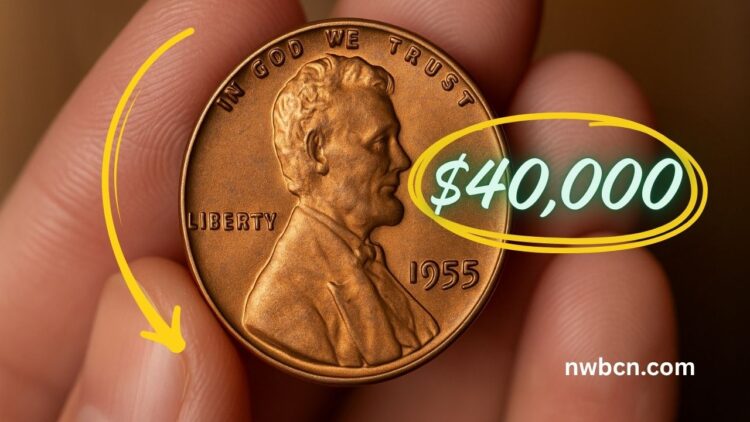The 1955 Doubled Die Obverse Penny is a famous error coin produced at the Philadelphia Mint when a misaligned obverse die received a second hubbing.
This resulted in dramatic doubling of date, LIBERTY, and IN GOD WE TRUST on the coin’s front—a striking error that is easily visible to the naked eye, unlike subtle doubling found in most double-die coins.
Its mintage figure was not low—the Philadelphia Mint produced over 33 million Lincoln cents in 1955—but the doubling die was used only briefly before being replaced. Experts estimate around 20,000 to 24,000 examples were struck before the error was noticed .
How the Mistake Happened
- Dual Hubbing Process: Early Mint dies required two hub impressions to sharpen details. In 1955, the second hubbing misaligned, causing heavy doubling.
- Prompt Replacement: After detection, the die was quickly retired, making the use window short.
- Mixing Into Circulation: By then, thousands of error coins had already left the Mint, frequently ending up in change, pocket rolls, and even cigarette machines.
Rarity & Survival Estimates
- Struck: An estimated 20,000–24,000 error cents.
- Surviving: Most are in circulated grades, with only a few thousand well-preserved uncirculated examples.
- Modern prominence: It remains one of the most iconic and well-documented U.S. mint errors.
Market Value & Notable Sales
While circulated examples can fetch $700–$1,200, uncirculated and high-grade specimens command much higher premium. Here’s an updated breakdown:
| Condition / Grade | Estimated Value | Notable Sales & Results |
|---|---|---|
| Circulated (VG–XF) | $700–$1,200 | — |
| Unc MS60–MS63 | $1,500–$3,000 | — |
| MS64–MS65 | $4,000–$8,000+ | Many eBay sales around $3K–$6K |
| MS66+ | $10,000–$40,000+ | eBay sale: NGC MS66RB at $39,950 (mid‑2025) |
| Top-tier world record | $124,875 | GreatCollections, MS‑64‑plus BN, Mar 2020 |
A coin in MS66 Red/Brown condition (gem quality) recently sold on eBay for nearly $40,000, illustrating the market’s strength for top-tier examples.
Identification: Spotting the Doubled Die
Key visual indicators:
- Strong doubling on the obverse—glare easily shows two overlapping images on LIBERTY, IN GOD WE TRUST, and the “1955” date.
- No doubling on the reverse—only the obverse die was affected.
- Die markers such as a parallel scratch near “CENT” or alignment errors on state names are confirmation signs.
For accurate identification, inspect under bright light and magnification. Professional graders at PCGS and NGC have confirmed this variety’s authenticity, which boosts market trust.
Why It Tops $40,000
- Eye-catching error: The doubling is easily visible without magnification, making it appeal to both collectors and casual finders.
- Limited window of die usage: Only twenty thousand or so produced, far fewer high-grade survivors.
- Popularity: Widely featured in publications and coin guides, fueling awareness and demand.
- Gem-value premiums: High grades like MS65 or MS66 earn huge premiums; clean surfaces and vibrant luster elevate value.
- Market trends: Prices have steadily climbed since the 2000s, with top specimens breaking mid-five-figure records.
1955 Doubled Die Penny Overview
| Feature | Description |
|---|---|
| Mint | Philadelphia |
| Mintage | ~33 million total Lincoln cents; ~20,000 DDO variety |
| Survival estimate | Thousands in circulation; hundreds to a few thousand uncirculated |
| Die error type | Obverse doubled die due to misaligned hubbing |
| Circulated value | $700–$1,200 |
| Unc MS60–MS63 | $1,500–$3,000 |
| Unc MS64–MS65 | $4,000–$8,000+ |
| MS66+ premium | $10,000–$40,000+ (e.g., $39,950 sale in 2025) |
| World auction record | $124,875 (MS64+ brown, GreatCollections, Mar 2020) |
| Key visual markers | Doubling on date, LIBERTY, motto; die scratch markers |
Investing or Selling
- Professional grading by PCGS or NGC confirms authenticity and grade, commanding higher market prices.
- Red/Brown versus Brown: full “Red” luster brings extra value; brown coins are still desirable but modestly priced.
- Condition is critical: each grade jump notably increases price; MS66 examples are rare.
- Avoid cleaned or altered coins: Cleaning damages surfaces and devalues the coin.
- Stay informed: Track auction platforms and recent sales for real-time market insights.
The 1955 Doubled Die Penny exemplifies how a simple mint error can transform an everyday coin into a collectible revered by numismatists. With visible doubling, a finite number produced, and proven market demand, especially in gem-grade condition, prices exceed $40,000 for top examples. For coin collectors and investors alike, spotting this error can be a career-defining find.
FAQs
Q1: Can any 1955 penny be a doubled die?
No. Only those produced at the Philadelphia Mint during the specific mis-hubbed batch display the distinctive obverse doubling. Date, motto, and LIBERTY must show clear doubling.
Q2: What grade do I need to reach $40,000+ value?
That level requires gem-quality certification—typically MS66 RB or higher—along with strong luster and clean surfaces.
Q3: How do I verify my coin isn’t counterfeit or cleaned?
Submit it to PCGS or NGC for grading. They authenticate die type, condition, and ensure the coin is uncleaned and original.
